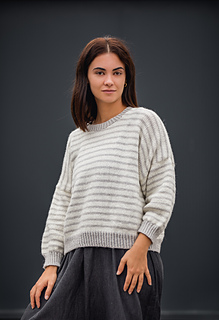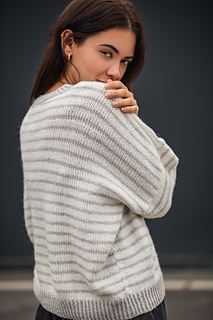patterns >  Angela Quaresma's Ravelry Store
Angela Quaresma's Ravelry Store
> Maria Riscas Sweater




Maria Riscas Sweater
The Maria Riscas is a very warm, lightweight, and
comfortable sweater, both to knit and to wear.
This sweater has a relatively simple construction,
with dropped shoulders.
It has a few details that give it personality, such
as the increase details at the armholes and the
striped pattern.
It is knitted from the bottom up, in the round, up until
to the armhole zone. From there, the back and front
are knitted separately, in right and wrong rows,
until finishing with the neckline. Finally, stitches are
picked up to knit the sleeves
YARN
2 (3, 3, 4, 4, 5) balls of Marialva, from Rosários 4, color 01 – color A;
2 (2, 2, 2, 3, 3) balls of Marialva, from Rosários 4, color 03 – color B.
GAUGE
In jersey stitch, 18sts and 26rows – 10 x 10 cm, with 5mm
needle, locked.
NEEDLES
5mm circular needles, (or the required needle size to obtain
the correct gauge) and 4mm or 4,5mm circular needles for
hems.
SIZES
1 (2, 3, 4, 5, 6)
FINISHED MEASUREMENTS
Bust circumference 115 (120, 125, 131, 137, 142) cm with
positive ease of 25-30 cm
PT:
FIO
2 (3, 3, 4, 4, 5) novelos de Marialva da Rosários 4 ,cor 01 –
cor A;
2 (2, 2, 2, 3, 3) novelos de Marialva da Rosários 4, cor 03 –
cor B.
AMOSTRA
Fazer a amostra em ponto jersey com agulhas 5mm: 18ms
e 26carr – 10 x 10 cm (depois de bloqueada)
AGULHAS
1 par de agulhas circulares de 5mm, com cabo de 80cm
ou maior (se necessário, ajustar o número da agulha para
obter o valor da amostra) e 1 par de agulhas circulares de
4mm ou 4,5mm para os canelados.
TAMANHOS
1 (2, 3, 4, 5, 6)
MEDIDAS FINAIS
115 (120, 125, 131, 137, 142) cm (estas medidas incluem uma
folga positiva de cerca de 25 a 30 cm).
A Camisola Maria Riscas é uma camisola bastante
quentinha, leve e muito confortável, tanto de
tricotar como a vestir.
Esta camisola tem uma construção relativamente
simples, de “ombros caídos”, sem recurso a
costuras laterais no corpo. Tem alguns detalhes
que lhe dão personalidade, como os pormenores
de aumentos nas cavas e o padrão riscado.
É tricotada de baixo para cima, em circular, até à
zona das cavas. Depois, a partir daí, a parte das
costas e frente são tricotadas separadamente,
em carreiras de direito e avesso, até finalizar com
a modelagem do decote. Por fim, levantam-se
malhas para tricotar as mangas.
120 projects
stashed
63 times
- First published: November 2025
- Page created: November 20, 2025
- Last updated: November 20, 2025 …
- visits in the last 24 hours
- visitors right now




